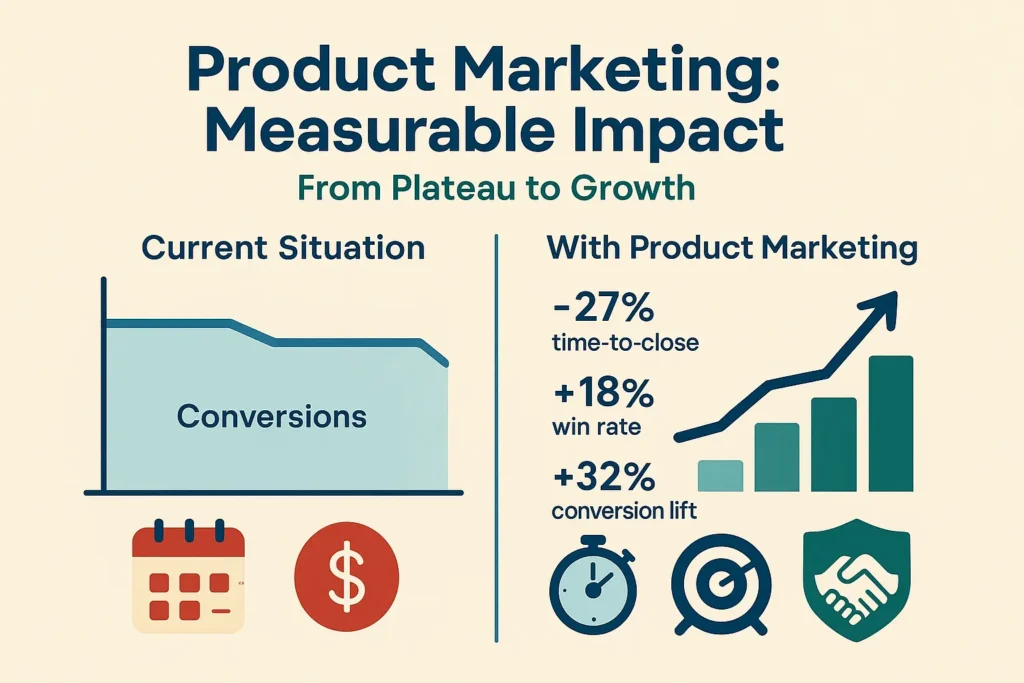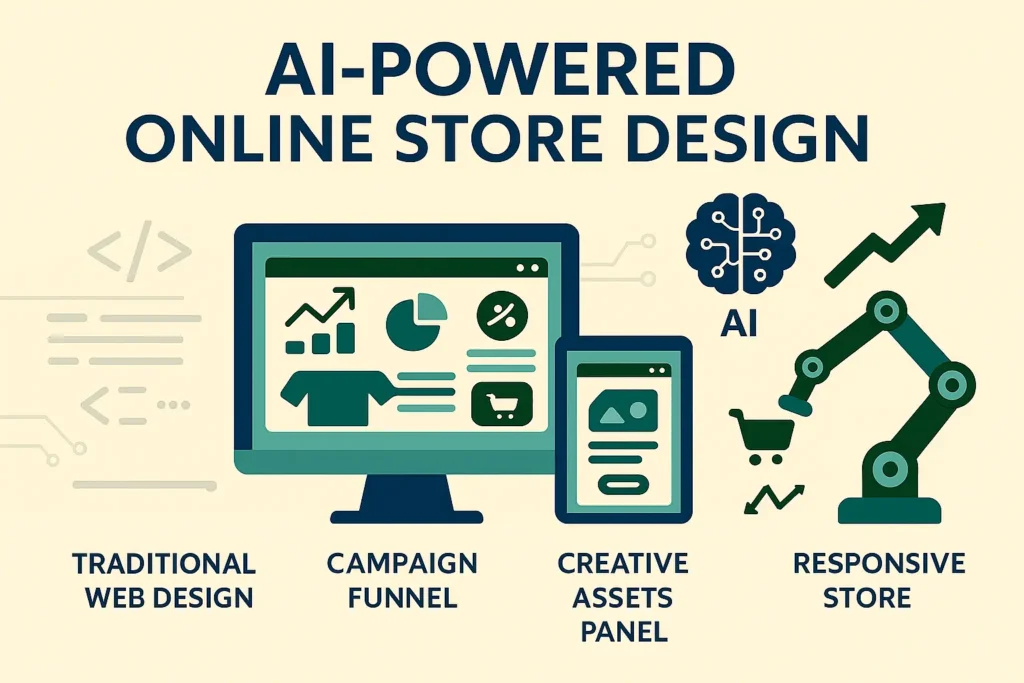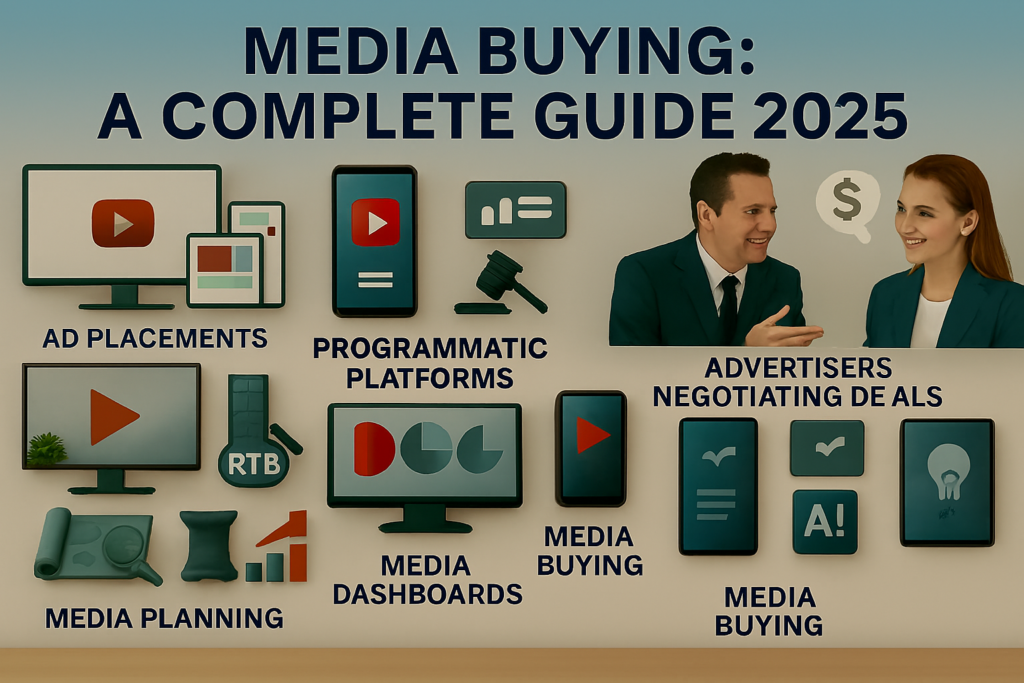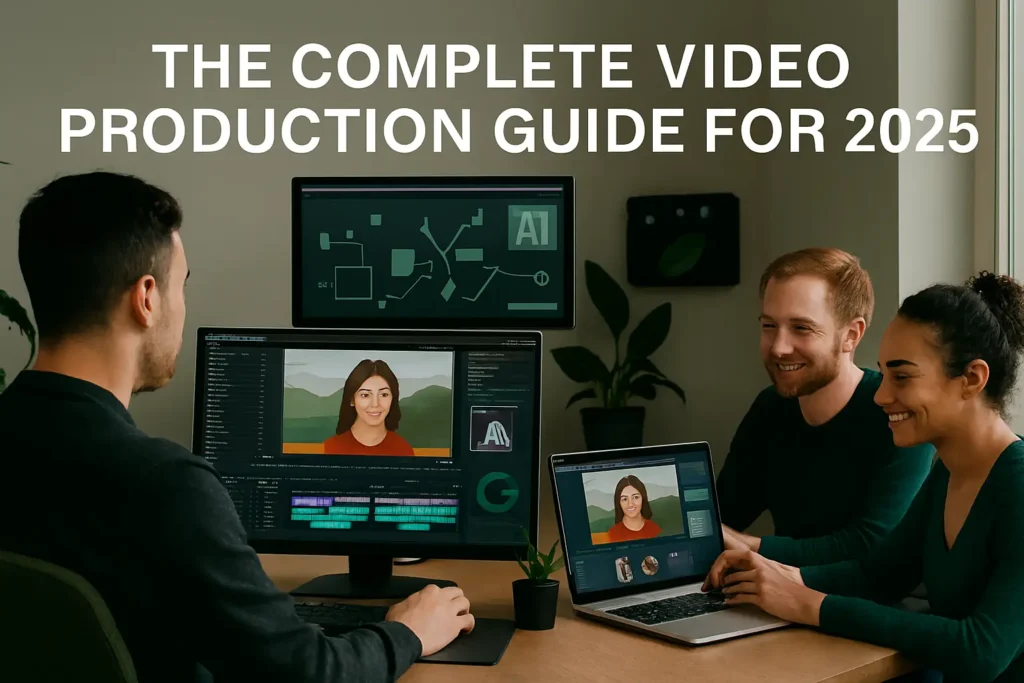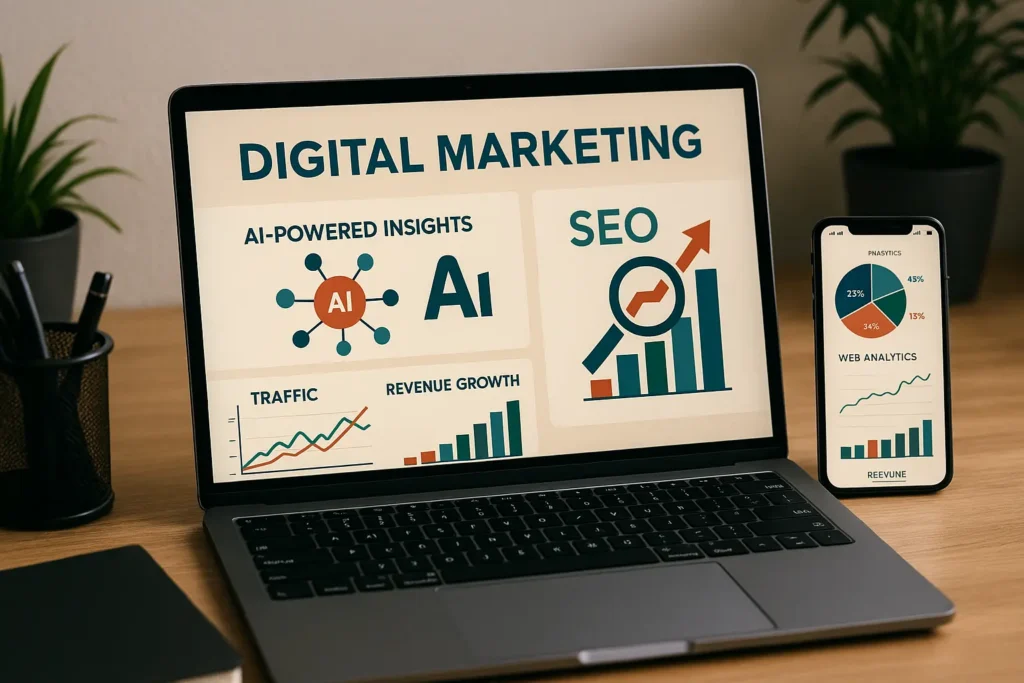
Web Development: The Complete Guide
Web Development Guide 2025: Build Websites That Work
You’re standing at the threshold of one of the most dynamic and rewarding fields in technology. Web Development has evolved from a niche technical skill into the backbone of our digital economy, touching every industry from healthcare to entertainment, from startups to Fortune 500 companies.
Whether you’re scrolling through social media, shopping online, or managing your bank account, you’re interacting with the work of web developers. These digital architects create the websites and applications that power our connected world. The demand for skilled developers continues to surge, with companies desperately seeking professionals who can bring their digital visions to life.
In this comprehensive guide, you’ll discover everything you need to know about entering the world of Web Development. From understanding the fundamental concepts to mapping out your learning journey, you’ll gain the knowledge and confidence to start building your career in this exciting field. You might be surprised to learn that many successful developers started exactly where you are now – curious, motivated, and ready to learn.
Setting realistic expectations is crucial for your success. Web development isn’t something you’ll master overnight, but with consistent effort and the right guidance, you can start building functional websites within weeks and develop professional-level skills within months. Your journey will be filled with challenges and breakthroughs, frustrating debugging sessions, and exhilarating moments when your code finally works perfectly.
Understanding Web Development: Foundations and Core Concepts
You need to understand what Web Development actually encompasses before diving into the technical details. Web development refers to the comprehensive process of creating, building, and maintaining websites and web applications that function on the internet. This field is much broader than many people realize, involving everything from simple static websites to complex web applications that handle millions of users.
The distinction between web development, web design, and web programming often confuses newcomers. Web design focuses primarily on the visual and user experience aspects – how a website looks and feels. Programming specifically refers to the coding and technical implementation. Web development encompasses both, plus project management, testing, deployment, and ongoing maintenance.
Modern websites serve as the digital storefronts,
communication hubs, and operational centers for businesses worldwide. You’re not just learning to write code; you’re learning to create digital experiences that solve real problems for real people. Every website you build has the potential to inform, entertain, connect, or empower users across the globe.
Client-side development happens in the user’s browser – it’s what visitors see and interact with directly. Server-side development occurs on web servers – the behind-the-scenes processing that makes dynamic functionality possible. Understanding this fundamental separation helps you grasp why different technologies and skills are needed for different aspects of web development.
The relationship between domains, hosting, and websites forms the foundation of how the internet works. Your domain name serves as the address where people find your website, web hosting provides the server space where your files live, and your website files contain the actual content and functionality that users experience.
The Three Pillars of Web Development: Front-End, Back-End, and Full-Stack
Front-end development puts you in direct contact with user experience creation. As a front-end developer, you’ll craft the visual elements, interactive features, and user interfaces that people see and use. You’ll spend your time ensuring websites look beautiful on desktop computers, tablets, and smartphones while maintaining fast loading speeds and intuitive navigation.
Your front-end work involves translating design mockups into living, breathing web pages. You’ll consider how users interact with buttons, forms, and menus. Browser compatibility becomes your constant consideration – ensuring your creations work seamlessly across Chrome, Firefox, Safari, and Edge. Responsive design skills allow you to create websites that automatically adapt to different screen sizes and devices.
Back-end development places you behind the curtain, building the server logic and database systems that power dynamic websites. You’ll create the systems that process user registrations, handle online payments, manage content updates, and store user data securely. Back-end developers ensure websites can handle traffic spikes, process complex calculations, and integrate with other services and APIs.
Database management becomes second nature as you design systems to store and retrieve information efficiently.
You’ll architect server infrastructure, implement security measures, and optimize performance for thousands or millions of concurrent users. API development allows your back-end systems to communicate with mobile apps, other websites, and third-party services.
Full-stack development combines both front-end and back-end skills, making you a versatile developer capable of building complete web applications independently. You’ll understand how all pieces of the web development puzzle fit together, from user interface design to database architecture. This comprehensive knowledge makes you valuable to small teams and startups that need developers who can wear multiple hats.
Choosing between specialization and full-stack development depends on your interests and career goals. Specialists often develop deeper expertise and command higher salaries in their chosen area. Generalists enjoy more variety in their work and better understand the complete development process, making them excellent candidates for leadership roles and entrepreneurial ventures.
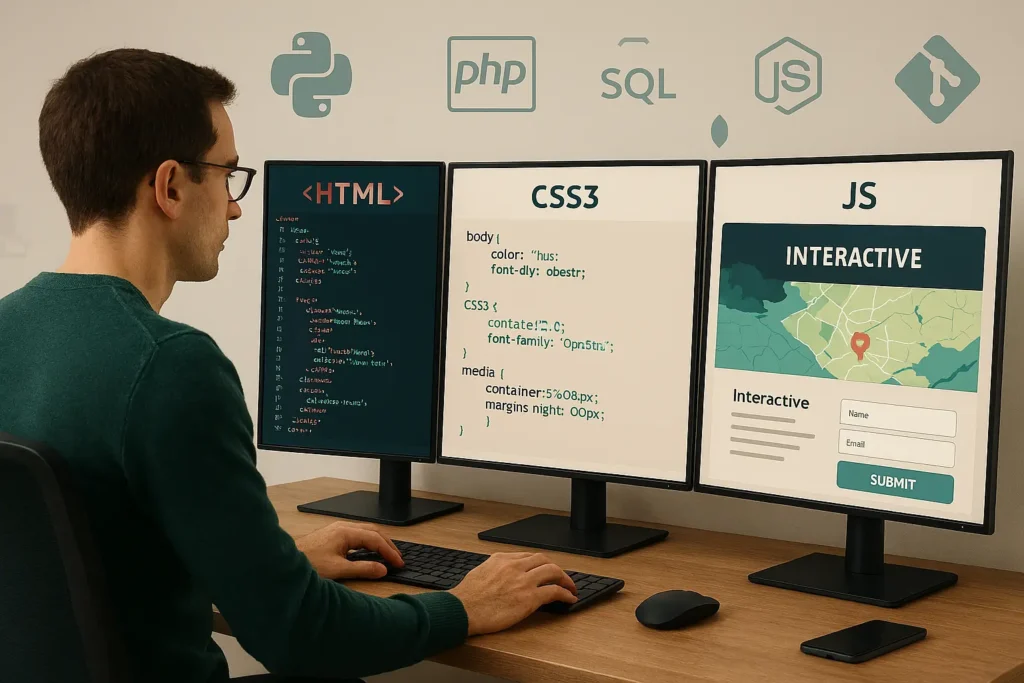
Essential Technologies: The Building Blocks of the Web
HTML5 forms the structural foundation of every website you’ll ever build. Think of HTML as the skeleton that gives your web pages their basic structure and meaning. You’ll use HTML to define headings, paragraphs, links, images, and forms. Modern HTML5 includes semantic elements that help search engines and accessibility tools better understand your content, making your websites more discoverable and inclusive.
CSS3 transforms your HTML structures into visually appealing designs. With CSS, you’ll control colors, fonts, layouts, animations, and responsive behavior. Advanced CSS features like Flexbox and Grid give you powerful tools for creating complex layouts that work across all devices. CSS animations and transitions add polish and interactivity that make your websites feel modern and engaging.
JavaScript breathes life into your static HTML and CSS, enabling interactive features and dynamic content updates. You’ll use JavaScript to validate forms, create image galleries, build interactive maps, and fetch new content without page reloads. Modern JavaScript has evolved into a powerful language capable of handling complex applications and real-time features.
Server-side programming languages each offer unique advantages for different types of projects.
Python’s readable syntax and extensive libraries make it popular for data-driven websites and rapid prototyping. PHP powers a significant portion of the web, including WordPress sites. Node.js allows you to use JavaScript for both front-end and back-end development, streamlining your learning process.
Database technologies divide into two main categories: SQL databases like MySQL and PostgreSQL excel at handling structured data and complex relationships, while NoSQL databases like MongoDB offer flexibility for rapidly changing data requirements. Your choice depends on your project’s specific needs, scalability requirements, and data structure.
Version control with Git becomes essential as you work on larger projects or collaborate with other developers. Git tracks changes to your code over time, allowing you to experiment with new features without fear of breaking working functionality. Platforms like GitHub, GitLab, and Bitbucket provide cloud-based repositories and collaboration tools that connect you with the global developer community.
Popular Frameworks and Libraries: Accelerating Development
React, Vue.js, and Angular represent the three dominant front-end frameworks that can significantly accelerate your development process. React’s component-based architecture makes it easier to build and maintain complex user interfaces, while its large community provides abundant learning resources and third-party libraries. Vue.js offers a gentler learning curve with excellent documentation, making it popular among developers transitioning from traditional web development.
Angular provides a comprehensive framework with built-in solutions for routing, form handling, and HTTP communications. Your choice between these frameworks often depends on project requirements, team preferences, and job market demands in your area. Each framework has its strengths, and learning any of them thoroughly is more valuable than superficial knowledge of all three.
CSS frameworks like Bootstrap and Tailwind CSS can dramatically speed up your styling workflow. Bootstrap provides pre-built components and responsive grid systems that work out of the box, perfect for rapid prototyping and projects with tight deadlines. Tailwind CSS takes a utility-first approach, giving you more granular control over styling while maintaining consistency and efficiency.
Deciding when to use frameworks versus vanilla code depends on project complexity,
Performance requirements and long-term maintenance considerations. Frameworks excel in complex applications with many interactive features, while simple websites might benefit from the performance and simplicity of vanilla HTML, CSS, and JavaScript.
Back-end frameworks provide structure and common functionality for server-side development. Express.js offers a minimalist approach for Node.js applications, giving you the flexibility to structure your application as needed. Django includes batteries for rapid Python development, with built-in authentication, admin interfaces, and security features. Laravel brings elegant syntax and powerful features to PHP development.
Content Management Systems like WordPress, Drupal, and Joomla offer different approaches to website creation and management. WordPress dominates the market with its user-friendly interface and extensive plugin ecosystem, making it excellent for blogs, business websites, and even e-commerce stores. Understanding how to customize and extend these systems opens up numerous freelance and employment opportunities.
The Web Development Process: From Concept to Launch
Planning and requirements gathering set the foundation for successful web development projects. You’ll learn to ask the right questions about project goals, target audience, functional requirements, and technical constraints. Thorough planning prevents costly changes later in the development process and ensures your final product meets client expectations and user needs.
Design and wireframing help you visualize the user experience before writing a single line of code. Wireframes serve as blueprints that show page layouts, navigation flows, and content organization. This planning phase allows you to identify potential usability issues and technical challenges early, when they’re much easier and cheaper to address.
Development phases typically follow a structured approach, whether you’re using Agile methodologies, waterfall processes, or hybrid approaches. You’ll learn to break large projects into manageable tasks, set realistic timelines, and maintain consistent progress. Regular communication with stakeholders keeps projects on track and ensures everyone understands the current status and upcoming milestones.
Testing strategies encompass unit testing for individual functions,
Integration testing for system components and user testing for overall experience validation. Automated testing tools can catch bugs before they reach users, while manual testing ensures your applications work intuitively for real people. Cross-browser and device testing ensures consistent experiences across different platforms.
Deployment and hosting options range from simple shared hosting for basic websites to complex cloud infrastructure for high-traffic applications. You’ll need to understand different hosting types, domain management, SSL certificates, and deployment workflows. Modern deployment practices often involve continuous integration and deployment pipelines that automatically test and deploy code changes.
Maintenance and ongoing updates form a crucial but often overlooked aspect of web development. Websites require regular security updates, content changes, feature additions, and performance optimizations. Building maintainable code and establishing update procedures ensures your projects remain secure, functional, and relevant over time.

Career Paths and Opportunities in Web Development
Traditional employment offers stability, benefits, and opportunities to work on large-scale projects with experienced teams. You’ll find web developer positions across industries, from tech companies and digital agencies to healthcare organizations, educational institutions, and government agencies. Employment provides structured learning environments, mentorship opportunities, and clear career advancement paths.
Freelancing gives you flexibility, variety, and potentially higher hourly rates, but requires strong business skills and self-discipline. As a freelancer, you’ll manage client relationships, handle project scoping and pricing, and take responsibility for your own professional development. Successful freelancers often specialize in specific niches or technologies, allowing them to command premium rates for their expertise.
Entrepreneurship allows you to build your own products and potentially create passive income streams. Many successful web developers have built and sold their own applications, created online courses, or started development agencies. The technical skills you learn in Web Development provide an excellent foundation for understanding how to build and scale digital products.
Specialization areas offer opportunities to develop deep expertise in specific domains.
E-commerce development involves payment processing, inventory management, and conversion optimization. Mobile-responsive development focuses on creating seamless experiences across devices. Enterprise application development requires an understanding of complex business requirements, security compliance, and system integration.
Salary expectations vary significantly based on location, experience level, and specialization. Entry-level developers can expect competitive starting salaries that increase rapidly with experience and skill development. Senior developers and specialists often earn well above national average salaries, with additional compensation through bonuses, stock options, and consulting opportunities.
Remote work opportunities in web development have exploded, especially following global shifts toward distributed teams. Remote work allows you to access job opportunities regardless of your geographic location, work with international teams, and often achieve a better work-life balance. Building strong communication and self-management skills becomes crucial for remote success.
Essential Skills for Modern Web Developers
Programming language proficiency forms the technical foundation of your development career. You don’t need to master every language, but deep knowledge of at least one front-end and one back-end language opens up numerous opportunities. Focus on understanding fundamental programming concepts like variables, functions, loops, and data structures – these concepts transfer between languages.
Database design and management skills become increasingly important as you work on more complex projects. Understanding how to structure data efficiently, write optimized queries, and maintain data integrity prevents performance problems and security vulnerabilities. Both SQL and NoSQL database experience broadens your project capabilities and job prospects.
Security best practices protect your applications and users from increasingly sophisticated cyber threats. You’ll need to understand common vulnerabilities like SQL injection, cross-site scripting, and authentication bypass. Implementing proper security measures isn’t optional – it’s a fundamental responsibility that protects both your reputation and your users’ sensitive information.
Performance optimization ensures your websites load quickly and provide smooth user experiences. You’ll learn to optimize images, minimize HTTP requests, implement caching strategies, and write efficient code. Page speed directly impacts user satisfaction, search engine rankings, and conversion rates, making performance optimization a valuable skill for any developer.
SEO fundamentals help ensure your websites can be found by search engines and users.
Understanding how search engines crawl and index websites, implementing proper meta tags and structured data, and optimizing for relevant keywords make your websites more successful. Technical SEO knowledge also helps you build SEO-friendly architectures from the ground up.
Problem-solving and analytical thinking distinguish great developers from average ones. You’ll encounter bugs, integration challenges, and performance issues that require methodical investigation and creative solutions. Developing strong debugging skills and learning to break complex problems into smaller, manageable pieces accelerates your development speed and reduces frustration.
Communication and client management skills become essential as you advance in your career. You’ll need to explain technical concepts to non-technical stakeholders, gather requirements from clients who may not know exactly what they want, and collaborate effectively with designers, marketers, and project managers. Clear communication prevents misunderstandings and ensures project success.
Keep reading and uncover secrets that can change the way you work. Top Website Development Services in Saudi Arabia Powered by AI to Boost Your Business
Learning Pathways: How to Become a Web Developer
Computer science degrees provide comprehensive theoretical foundations and structured learning environments. University programs cover algorithms, data structures, software engineering principles, and mathematics that strengthen your problem-solving abilities. Degrees also provide networking opportunities, internship programs, and career services that can accelerate your job search.
Web development bootcamps offer intensive, practical training designed to prepare you for entry-level positions in months rather than years. Bootcamps focus on current industry technologies and often provide career support, including resume assistance and interview preparation. The immersive environment and peer learning can accelerate your progress, though the pace can be challenging.
Community college programs provide affordable, accessible education with flexible scheduling options. Many community colleges offer associate degrees or certificates in web development or related fields. These programs often maintain connections with local employers and can provide excellent stepping stones to four-year degrees or direct employment.
Self-directed learning approaches offer maximum flexibility and cost-effectiveness,
though they require strong self-discipline and motivation. Online platforms like freeCodeCamp, Coursera, and Udemy provide structured courses, while YouTube tutorials and documentation offer free learning resources. Building personal projects and contributing to open source demonstrates your skills to potential employers.
Creating an effective learning plan helps you stay focused and make consistent progress. Set specific, measurable goals with realistic timelines. Balance theoretical learning with hands-on practice, and regularly assess your progress against your goals. Join online communities and local meetups to stay motivated and get help when you’re stuck.
Setting milestones and tracking progress maintains momentum and provides motivation throughout your learning journey. Celebrate small victories like completing your first website, mastering a new framework, or landing your first client. Regular progress reviews help you identify areas that need more attention and adjust your learning plan accordingly.
Keep reading and uncover secrets that can change the way you work. How an AI-Powered Website Design Company in Riyadh Revolutionizes User Experience and Maximizes Business Profits
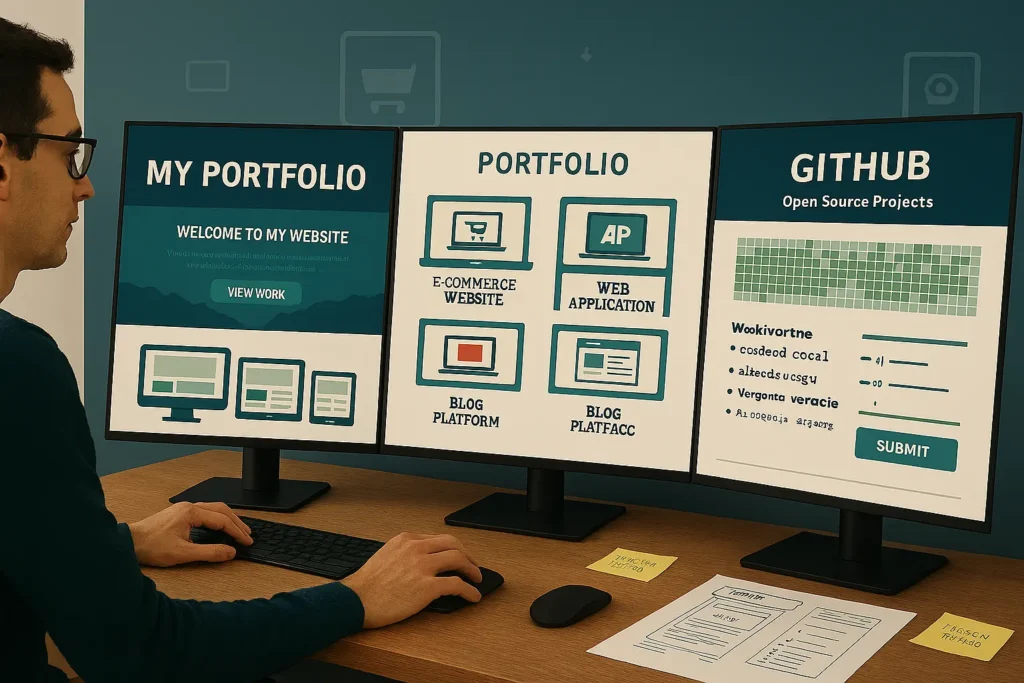
Building Your Portfolio and Personal Brand
Essential projects showcase different aspects of your web development skills to potential employers or clients. Build a responsive personal website that demonstrates your design sensibility and technical skills. Create a dynamic web application that shows your ability to work with databases and APIs. Include a mobile-responsive e-commerce site or content management system to demonstrate practical business application knowledge.
Your personal website serves as your digital business card and portfolio showcase. Make it fast-loading, mobile-friendly, and representative of your best work. Include an about section that tells your story, a portfolio section highlighting your projects, and clear contact information. Keep content updated and ensure all links and features work perfectly – your website reflects your attention to detail and professionalism.
Contributing to open source projects demonstrates collaboration skills and gives back to the developer community. Start with small contributions like fixing typos in documentation or adding minor features. As you gain experience, tackle larger issues and eventually maintain your own open source projects. Open source contributions provide concrete examples of your code quality and collaborative abilities.
Documenting your development journey through blog posts,
Social media, or video content, helps establish your expertise and connects you with other developers. Share what you’re learning, challenges you’ve overcome, and insights you’ve gained. This content marketing approach can attract potential employers or clients while reinforcing your own learning through teaching others.
Networking through tech communities, both online and in-person, opens doors to job opportunities and mentorship relationships. Attend local meetups, participate in online forums, and engage with other developers on social media platforms. Building genuine relationships within the tech community provides support, advice, and often leads to job referrals.
Preparing for technical interviews requires practice with coding challenges, system design questions, and behavioral interviews. Practice common algorithms and data structures problems on platforms like LeetCode or HackerRank. Prepare to explain your projects in detail and discuss the technical decisions you made. Mock interviews with friends or mentors help build confidence and identify areas for improvement.
Keep reading and uncover secrets that can change the way you work. How Smart Back-End and Front-End Services Help Attract Customers and Increase Sales
Industry Trends and Future of Web Development
Artificial intelligence integration is transforming how websites personalize content, optimize performance, and automate routine tasks. You’ll see AI-powered chatbots, content recommendation systems, and automated testing tools becoming standard features. Understanding how to implement and work alongside AI tools positions you for future opportunities while making your current work more efficient.
WebAssembly enables high-performance applications to run in web browsers at near-native speeds. This technology opens up possibilities for complex applications like video editing, 3D modeling, and scientific computing to run directly in browsers. As WebAssembly adoption grows, developers with an understanding of this technology will have advantages in performance-critical applications.
Progressive Web Apps blur the line between websites and mobile applications, providing app-like experiences through web technologies. PWAs offer offline functionality, push notifications, and native-like performance while remaining accessible through web browsers. This approach reduces development costs while expanding reach across different platforms and devices.
Mobile-first design has evolved from a trend to a necessity,
Mobile traffic now exceeds desktop usage on most websites. You’ll need to prioritize mobile experience in every project, considering touch interactions, limited screen space, and varying network conditions. Responsive design skills and mobile performance optimization become increasingly critical for user satisfaction.
Security challenges continue evolving as cyber threats become more sophisticated. You’ll need to stay current with security best practices, implement proper authentication and authorization systems, and understand privacy regulations like GDPR and CCPA. Security knowledge protects your applications and users while reducing legal and financial risks for your employers or clients.
Performance optimization trends focus on Core Web Vitals and user experience metrics that directly impact search rankings and conversion rates. Techniques like lazy loading, code splitting, and image optimization become standard practices. Understanding performance monitoring tools and optimization strategies ensures your websites compete effectively in search results and provide excellent user experiences.
Keep reading and uncover secrets that can change the way you work. E-commerce in Saudi Arabia: How to Boost Your Profits with Our AI-Powered Services
Getting Started: Your First Steps Into Web Development
Setting up your development environment creates the foundation for productive coding sessions. Install a modern code editor like Visual Studio Code with helpful extensions for syntax highlighting, auto-completion, and debugging. Set up version control with Git and create accounts on GitHub for code storage and collaboration. Choose a local development server solution for testing your websites before publishing them online.
Essential tools and software recommendations include text editors, browsers with developer tools, image editing software, and project management applications. Free options like Visual Studio Code, GIMP, and Firefox Developer Edition provide professional-grade capabilities without initial investment. Paid tools like Adobe Creative Suite and JetBrains IDEs offer advanced features that may justify their cost as your skills and income grow.
Your first HTML page tutorial starts with creating a simple but complete webpage.
Begin with proper document structure, including DOCTYPE, HTML, head, and body tags. Add meaningful content with headings, paragraphs, links, and images. Style your page with basic CSS to understand how styling works. Add simple JavaScript interactions to see how programming brings websites to life.
Practice projects for beginners should gradually increase in complexity while reinforcing fundamental skills. Start with a personal resume website to practice HTML structure and CSS styling. Build a simple blog to understand content organization and navigation. Create an interactive quiz or calculator to practice JavaScript programming. Each project should teach new concepts while reinforcing previous learning.
Finding mentors and learning communities provides support, guidance, and motivation throughout your journey. Join online communities like Reddit’s webdev community, Stack Overflow for technical questions, and Discord servers focused on web development. Attend local meetups and hackathons to meet other developers in person. Don’t be afraid to reach out to experienced developers for advice – many are happy to help newcomers.
Keep reading and uncover secrets that can change the way you work. Innovative Web Development Company in Tabuk and Najran Driving Business Success with AI
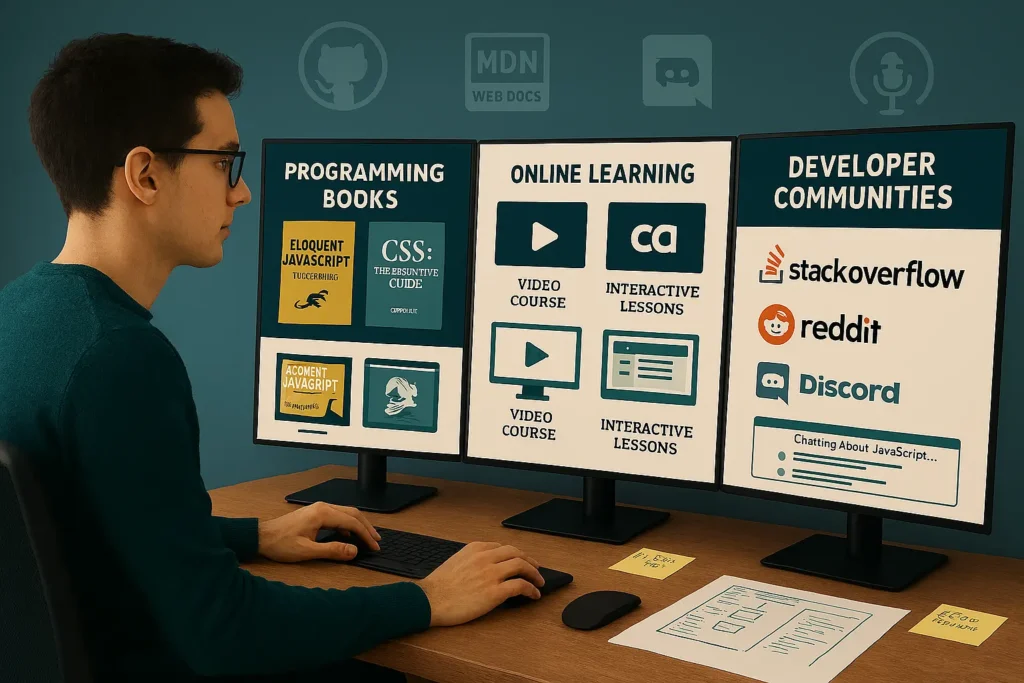
Resources for Continued Growth and Learning
Quality books provide deep, comprehensive knowledge that complements online tutorials and courses. “Eloquent JavaScript” offers thorough JavaScript fundamentals, while “CSS: The Definitive Guide” covers styling comprehensively. “You Don’t Know JS” series dives deep into JavaScript concepts that many developers misunderstand. Physical books provide focused learning without online distractions and serve as valuable reference materials.
Online courses and tutorials offer structured learning paths with interactive exercises and projects. Platforms like freeCodeCamp provide comprehensive curricula from beginner to advanced levels. Udemy, Coursera, and Pluralsight offer professionally produced courses on specific technologies and frameworks. YouTube channels like Traversy Media and The Net Ninja provide free, high-quality tutorials on current technologies.
Developer communities and forums provide peer support
Networking opportunities and knowledge sharing. Stack Overflow remains the go-to resource for technical questions and answers. Reddit communities offer discussions about career advice, industry trends, and specific technologies. Discord servers provide real-time chat opportunities with other learners and experienced developers.
Documentation and official resources should become your first stop for authoritative information about technologies and frameworks. MDN Web Docs provides comprehensive HTML, CSS, and JavaScript references. Framework documentation, like React, Vue, and Angular docs, offers authoritative guides and examples. Reading official documentation improves your understanding and keeps you current with best practices.
Productivity tools and applications help you work more efficiently and stay organized. Code editors with extensions automate repetitive tasks and catch errors early. Project management tools help you track tasks and deadlines. Time tracking applications help you understand how long different types of work actually take, improving your project estimates and productivity.
Staying updated with industry changes requires following reliable news sources and thought leaders. Websites like Smashing Magazine, A List Apart, and CSS-Tricks publish high-quality articles about web development trends and techniques. Podcasts like Syntax and ShopTalk Show provide discussions about current industry topics during commutes or exercise time.
Keep reading and uncover secrets that can change the way you work. AI-Powered Web Design Company: Enhancing User Experience and Boosting Sales in Saudi Arabia
Frequently Asked Questions (FAQ)
How long does it take to become a web developer?
The timeline varies significantly based on your learning approach, time commitment, and career goals. With full-time dedicated study, you can learn enough to build basic websites in 2-3 months and reach job-ready skills in 6-12 months. Part-time learning typically takes 12-24 months to reach employability. Remember that learning continues throughout your career as technologies evolve and you tackle more complex projects.
Do I need a computer science degree to get hired?
While many web developers have computer science degrees, they’re not strictly required for most positions. Employers increasingly value demonstrable skills, strong portfolios, and practical experience over formal education credentials. Bootcamp graduates, self-taught developers, and career changers successfully enter the field regularly. Focus on building strong technical skills and a compelling portfolio to demonstrate your capabilities.
What’s the difference between web development and software development?
Web development specifically focuses on creating websites and web applications that run in browsers, while software development encompasses all types of software, including desktop applications, mobile apps, and system software. Web Development skills often transfer to broader software development roles, and many concepts overlap. Developers can transition to software development roles and vice versa with additional learning.
Which programming language should I learn first?
For beginners interested in Web Development, start with HTML and CSS to understand web page structure and styling, then add JavaScript for interactivity. This front-end foundation provides immediate visual feedback and builds confidence. If you’re more interested in back-end development, Python offers beginner-friendly syntax and versatile applications. Choose based on your interests and local job market demands rather than trying to find the “perfect” first language.
How much can I expect to earn as a web developer?
Web developer salaries vary widely based on location, experience level, specialization, and company size. Entry-level developers typically earn $40,000-$65,000 annually, while experienced developers can earn $80,000-$120,000 or more. Specialists in high-demand areas like mobile development or security often command premium salaries. Freelancers may earn higher hourly rates but must account for inconsistent work and additional business expenses.
Is web development a good career choice for career changers?
Web development offers excellent opportunities for career changers due to its relatively accessible entry requirements, strong job market, and transferable skills. Many successful developers started in completely different fields, bringing valuable perspectives and soft skills to their new careers. The combination of creative and analytical work appeals to people from diverse backgrounds, and remote work opportunities provide flexibility for those transitioning careers.
Turn your goals into real achievements with our tailored services – request the service now.
Your Web Development Adventure Begins Here
You’ve now explored the comprehensive landscape of Web Development and discovered the exciting opportunities that await in this dynamic field. From understanding the fundamental technologies that power the web to mapping out practical learning pathways, you have the knowledge needed to make informed decisions about your development journey.
The skills you’ll gain through web development extend far beyond just building websites. You’ll develop problem-solving abilities, attention to detail, creative thinking, and technical expertise that serve you well in any career path. The logical thinking required for programming, the user empathy needed for good design, and the project management skills necessary for successful launches all contribute to your professional growth.
Your personalized action plan should reflect your specific interests, available time, and career goals. If you’re drawn to visual design and user experience, focus initially on front-end development with HTML, CSS, and JavaScript. If you prefer working with data and system logic, explore back-end development with languages like Python or Node.js. Remember that you can always expand your skills in different directions as you gain experience and discover new interests.
Setting both short-term and long-term goals maintains momentum and provides direction for your learning journey.
Short-term goals might include completing your first website, finishing an online course, or contributing to an open-source project. Long-term goals could involve landing your first development job, specializing in a particular technology stack, or starting your own development business.
The continuous learning mindset becomes your greatest asset in web development. Technologies evolve rapidly, new frameworks emerge, and best practices change regularly. Embrace this constant evolution as an opportunity for growth rather than a burden. Developers who remain curious and adaptable throughout their careers enjoy the most success and job satisfaction.
Welcome to the global community of web developers – a diverse, supportive group of professionals who share knowledge, collaborate on projects, and help each other grow. You’re joining millions of developers worldwide who wake up each day excited to build something new, solve interesting problems, and make a positive impact through technology. Your unique perspective and experiences will contribute to this community while you learn and grow alongside fellow developers.

